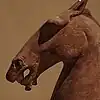Book on Numbers and Computation
The Book on Numbers and Computation (Chinese: 筭數書; pinyin: Suàn shù shū), or the Writings on Reckoning,[1] is one of the earliest known Chinese mathematical treatises. It was written during the early Western Han dynasty, sometime between 202 BC and 186 BC.[2] It was preserved among the Zhangjiashan Han bamboo texts and contains similar mathematical problems and principles found in the later Eastern Han period text of The Nine Chapters on the Mathematical Art.
Discovery
The text was found in tomb M247 of the burial grounds near Zhangjiashan, Jiangling County, in Hubei province, excavated in December–January 1983–1984.[2][3] This tomb belonged to an anonymous civil servant in early West Han dynasty. In the tomb were 1200 bamboo strips written in ink. Originally the strips were bound together with string, but the string had rotted away and it took Chinese scholars 17 years to piece together the strips. As well as the mathematical work the strips covered government statutes, law reports and therapeutic gymnastics.
On the back of the sixth strip, the top has a black square mark, followed by the three characters 筭數書,[4][5] which serve as the title of the rolled up book.
Content
The Suàn shù shū consists of 200 strips of bamboo written in ink, 180 strips are intact, the others have rotted. They consist of 69 mathematical problems from a variety of sources, two names Mr Wáng and Mr Yáng were found, probably two of the writers. Each problem has a question, an answer, followed by a method. The problems cover elementary arithmetic; fractions; inverse proportion; factorization of numbers; geometric progressions, in particular interest rate calculations and handling of errors; conversion between different units; the false position method for finding roots and the extraction of approximate square roots; calculation of the volume of various 3-dimensional shapes; relative dimensions of a square and its inscribed circle; calculation of unknown side of rectangle, given area and one side. All the calculations about circumference and area of circle are approximate, equivalent to taking π = 3. Calculations of pi were made more accurate with the work of Liu Xin (c. 46 BC – 23 AD), Zhang Heng (78–139 AD), Liu Hui (fl. 3rd century AD), and Zu Chongzhi (429–500).
Prior to discovery the oldest Chinese mathematical text were the Zhoubi Suanjing and The Nine Chapters on the Mathematical Art which dates from around 100 CE. Many topics are covered in both texts, however, error correction problems only appear in the Suàn shù shū, and the last two chapter of the nine chapters have no corresponding material in the Suàn shù shū.
The text has been translated to English by Christopher Cullen, director of the Needham Research Institute.[6]
Notes
- Dauben (2004), 151.
- Liu et al. (2003), 9.
- Dauben (2007), 201.
- Cullen, p117
- Cullen, Christopher (2007). "The Suàn shù shū , "Writings on reckoning": Rewriting the history of early Chinese mathematics in the light of an excavated manuscript". Historia Mathematica. 34: 10–44. doi:10.1016/j.hm.2005.11.006.
- The Suan shu shu 筭數書 'Writings on Reckoning'
References
- Christopher Cullen: The Suan shu shu Writings on reckoning, Needham Research Institute, pdf free download
- Cullen, Christopher (2007). "The Suàn shù shū , "Writings on reckoning": Rewriting the history of early Chinese mathematics in the light of an excavated manuscript". Historia Mathematica. 34: 10–44. doi:10.1016/j.hm.2005.11.006.
- Dauben, Joseph W. (2004). "The Suan Shu Shu (A Book on Numbers and Computation), A Preliminary Investigation" in Form, Zahl, Ordnung, 151–168. München: Franz Steiner Verlag. ISBN 3-515-08525-4.
- Dauben, Joseph W. (2007). "Chinese Mathematics" in The Mathematics of Egypt, Mesopotamia, China, India, and Islam: A Sourcebook, 187–384. Edited by Victor J. Katz. Princeton: Princeton University Press. ISBN 0-691-11485-4.
- Guilin Liu, Lisheng Feng, Airong Jiang, and Xiaohui Zheng. (2003). The Development of E-mathematics Resources at Tsinghua University Library (THUL)," in Electronic Information and Communication in Mathematics, 1–13. Edited by Fengshen Bai and Bernd Wegner. Berlin: Springer. ISBN 3-540-40689-1.
- Stephanie Pain, Histories: China's oldest mathematical puzzles, New Scientist, 30 July 2006.
- Péng Hào, Zhāngjiāshān Hànjiǎn "Suàn shù shū" zhùshì (The Hàn dynasty book on wooden strips "Suàn shù shū" found at Zhāngjiāshān with a commentary and explanation) Beijing, Science Press, (2001).
- Wu Wenjun ed, Zhong Guo Shu Xue Shi Da Xi(The Grand Series of History of Chinese Mathematics) vol 1, chapter 2, "Suan Shu Shu". ISBN 7-303-04555-4
- Rémi Anicotte (2019). Le Livre sur les calculs effectués avec des bâtonnets – Un manuscrit du -IIe siècle excavé à Zhangjiashan, Paris: Presses de l'Inalco. http://www.inalco.fr/publication/livre-calculs-effectues-batonnets-manuscrit-iie-siecle-excave-zhangjiashan
External links
- Full text of book Christopher Cullen: Suan shu shu Writings on reckoning Needham Research Institute
